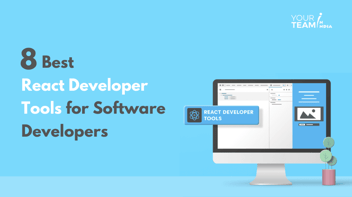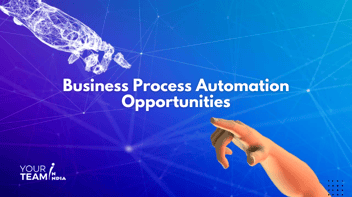RPA is a type of business process automation that allows anyone to define instructions for a robot or a “bot” to perform.
But, to be precise - There aren’t any physical robots involved in robotic process automation.
Instead, the “Robot” in robotic process automation is a software robot that can understand what’s on a screen, navigate systems, identify and extract data and perform a wide range of defined actions. Precisely, the robots are capable of carrying out a ton of error-free tasks faster and at high volume without taking a coffee break.
Furthermore, RPA automates everyday mundane and repetitive processes at the workplace. Imagine copy-paste tasks and moving files from one place to another - that’s how RPA boosts efficiency for organizations.
So, in the constant race to be the forerunner, companies are looking for ways to streamline processes, minimize costs and focus on value-added activities.
RPA comes as an attractive proposition addressing these concerns. And so it is no wonder that mid and large-size organizations are increasingly looking to hire RPA developers and implement Robotic Process Automation.
Learn More: Everything You Need To Know To Hire RPA Developers
As RPA continually climbs the hype–cycle curve, it’s easy to forget that technology is not a magic wand that you wave to create exceptional cost savings. Rather, the first few steps to integrating RPA into your business are crucial for success.
Here are 7seven secret ingredients that, if baked into the planning and execution of robotic process automation, will significantly manifold the chances of a successful outcome.
But, before you start any RPA implementation, it’s important to have the basics in place - “the right plan.” This ensures the RPA program’s goals and objectives are in synchronization with business goals and objectives.
7 Success Factors for RPA Implementation
First and foremost - “The People”
Common to any transformation, people hold the key, as people are the driving force behind accepting the change throughout the organization. This varies from leadership having to be change leaders to managers and professionals on the floor having to be open to new ways of working.
And once the RPA strategy and the implementation team have been identified, six subsequent factors become unskippable for successful RPA implementation:
Checking the Process Maturity
All processes are not suitable for RPA. RPA produces the best ROI when implemented on processes that are labor-intensive, repetitive, rule-based, and have a limited number of process exceptions.
RPA is a considerable choice for defined, mature, repetitive, and data-heavy processes.
So, to assess if the process is a potential choice for RPA, process maturity and RPA readiness assessments need to be done before robotic process automation execution. To achieve this, ensure the RPA business case and target ROIs are already lined before performing the process maturity and RPA readiness assessment.
The process maturity and RPA readiness assessment outcome will provide a vetted list of RPA processes. Moreover, the assessment can also identify a second tier of potential RPA processes, where small process redesign or standardization is needed before being automated.
This lets organizations eliminate several redundancies before implementing RPA while ensuring greater efficiency of implemented robots along with different numbers of exceptions and potential errors.
So, if an extensive RPA program is being implemented, it’s advisable to start by automating the most accessible processes. The knowledge and experience acquired from implementing the easy process first can then be used to automate the more complex processes.
A Healthy Reminder - This may sound easy, but remember, RPA is a new add-on to your organization and also, potentially, the people who are implementing the program.
Choosing the Right RPA Software
Unquestionably, there is numerous RPA software available in the market.
So, picking the right Robotic Process Automation software is crucial as it serves as your automation platform where you create your processes. Besides, consider the solution's scalability, product features roadmap, and AI potential.
Don’t Fall Prey To - The software products with definite capabilities and roadmap, mostly work like a macro, though marketing themselves like RPA solution.
An RPA software with good product features and scalability would allow you to create more efficient processes with minimum human interactions and stability for rolling RPA enterprise-wide.
Besides, when RPA software is combined with a strong product roadmap focusing on AI technology, you can scale up to cognitive RPA and other AI aspects. Thus, choosing the right RPA software is crucial, and not risk having write-off unsuccessful implementation and start from scratch.
RPA Technology Compatibility
When choosing an RPA technology partner, check the software's compatibility with your organization's systems.
Besides, the procurement process must consist of a comprehensive IT requirement review. The IT requirements review should include technical support, security and data standards, maintenance, hardware and software requirements, implementation costs, and licensing fees.
RPA software is easy-to-use and intuitive, though businesses and organizations considering RPA should still review the RPA process design and configuration interface. In layman's language, non-IT professionals should be easily able to configure and monitor the robots.
Furthermore, all advanced RPA technology providers have a control room feature that lets organizations schedule and monitors robot activities. It also highlights robots that didn't function properly and presents an error message notifying the point of failure. RPA software should also provide user access restriction functionality and comprehensive audit logs for each robot, ensuring RPA is appropriately managed.
Hire RPA Developers That are Right For Your Business
Most companies don’t have a dedicated team of RPA developers for Business to help successfully establish a Robotic Process Automation process, and that is why businesses and companies look for experienced RPA developers.
Therefore, the key to choosing the right RPA resources is to analyze whether it jells with the organization or not. Below are the parameters you should consider:
- The RPA experts should understand your industry and process areas being considered for RPA. It sounds simple, but most implementation partners will say they have experience in a spectrum of industries and processes - which might not necessarily be the case.
- Organizations should check for social proof and ask potential RPA consultants for RPA-specific client references similar to your business vertical. Ideally, the implementation partner has already worked with the organization and understands the business, processes, and information systems.
- Considering the size of the RPA implementation program, it’s equally crucial for clients to choose a partner who builds, tests, and deploys RPA solutions within the timeframe. Businesses and organizations should ensure that potential RPA implementation partners can address the deliverable challenge within the timeline.
Keep the expectations and final deliverables clear before choosing an RPA developer.
Outlining the Project Management
Whether RPA implementation is a small-scale project or a large-scale program, project governance and management practices are imperatives for successful implementation.
So, the primary step is to build a project management team and define the governance structure for RPA. Also, ensure the team includes the key personnel from the relevant business units and IT and project management professionals.
Next, secure executive and process owner buy-in. This will determine the goals of the RPA program, like minimizing person-hours and costs or improving the efficiency or quality of work performed. After all, defining the main objective of the RPA program will help determine the RPA business case and ROI (Return On Investment). Besides, establish the rating process that is to be used in the maturity process and RPA readiness assessment.
Once the project management team and RPA program goals are established, it's easy to develop an RPA implementation plan.
Having a Change Management Strategy and Execution Plan
“Change management” is a critical element defining the success of any significant transformation. This approach helps in ensuring that organizations are capable of adapting to change.
Especially for RPA, the change is big, and it hits the core of an organization, leading people to fear that RPA would start to take over the workplace. This eventually causes resistance to change.
So, a good change management strategy and execution plan aligned to your corporate culture will help employees better understand change and their roles and responsibilities after the difference in the long run. Also, it will help ease this tension and simultaneously create a smooth adoption of RPA and future AI in the organization.
A trusted and experienced RPA consultant can bring forward good RPA knowledge and success stories and be the partner in the change RPA will bring in the future.
Built an RPA CoE(Centre Of Excellence)
COE is a central group that manages RPA deployment across the enterprise.
Simply put, CoE ensures you leverage the most out of your human-and-bot workforce.
The COE group consists of IT professionals, process managers, citizen developers, functional experts, and representatives from different verticals of the organization. Depending on the governance model, there might be strict authority over all RPA initiatives or even share governance responsibilities with respective business units. In either case, the CoE integrates standards and best practices providing leadership and technical expertise to ensure the enterprise gets the most out of its RPA investment.
Usually, in organizations, RPA start as a Proof of Concept (POC), but when a CoE comes into the picture, it can shoulder a lot of responsibilities like:
- Aligning the requirements and objectives of all stakeholders
- Providing RPA services and support
- Integrating RPA standards, processes, and best practices
- Building an enterprise-wide RPA strategy
- Offering centralized RPA governance
- Managing RPA change management from business as well as technical perspectives
- Educating and training employees on RPA skills
Finally… RPA is growing exponentially!
Companies look for methods to employ greater precision and efficiency in various processes to use RPA across business units and processes.
If still, you don’t know how to get your hands on the best RPA experts for your business, it’s like using a sledgehammer to swat a fly. So, don’t rush through RPA projects as a seat-of-the-pants exercise; plan extensively and evaluate your potential partner to hire RPA developers with bespoke experience.






